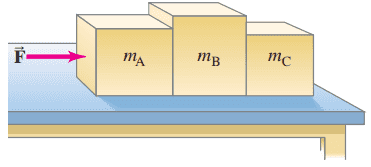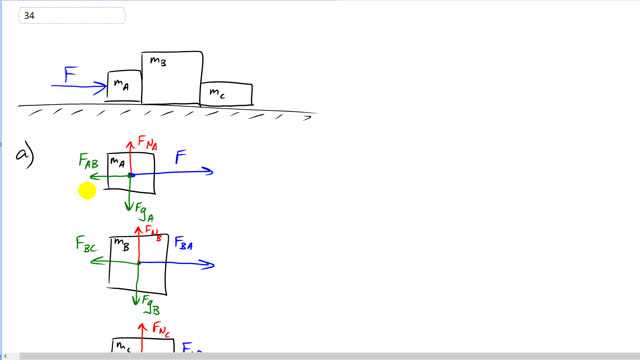
Three blocks on a frictionless horizontal surface are in contact with each other as shown in Fig. 4–54. A force is applied to block A (mass ).
- Draw a free-body diagram for each block.
- the acceleration of the system (in terms of , , and ),
- the net force on each block, and
- the force of contact that each block exerts on its neighbor.
- If and , give numerical answers to (b), (c), and (d). Explain how your answers make sense intuitively.


In order to watch this solution you need to have a subscription.
This is Giancoli Answers with Mr. Dychko. We'll start by drawing a free body diagram for each of these blocks A, B and C. Block a has the applied force on it to the right and it has the force on block A due to block B pushing to the left and as the normal force on block A upwards and force of gravity downwards. Block B is stuck in the middle and it has the force on block B due to block A which is the Newton's third law counterpart to this one. And it has the force on block B due to block C pushing to the left there and has a normal force up and down. And block C has only a force to the right and due to block B and it has the normal force upwards and gravity downwards. So, Part B asks for the acceleration of the system so, we can think of the system as a single block consisting of all three blocks together with a single force which is the applied force. And this is the net force because it's the only force horizontally, and so, it is equal to mass times acceleration and the mass is mA plus mB plus mC. And so, the acceleration then is, well, you can solve for by dividing both sides by that factor there that's being multiplied by a. And both sides get divided by this and you end up with a equals F over mA plus mB plus mC. And then Part C asks for the net force on each block so, on block A the net force is the mass of a times its acceleration. And so, we have mA times the acceleration we just found up here which we substitute in for a. So, it's mA times F divided by mA plus mB plus mC. And that's the same story for blocks B and C, the only difference is that we have a different mass being multiplied by the same acceleration in each case. And then part D asks for the contact force between each block. So, let's consider block A, its net force is F to the right. And the force on block A due to block B to the left. And that equals the mass of A times its acceleration because this is the net force and so it is mA, that's Newton's second law. And we'll do a bit of algebra and we'll solve for this contact force here, the force on A due to block B. Will move this to the right making it positive, move this to the left making the mA term negative and switch the sides around. And we have FAB equals F minus mA times a. And then I substitute for acceleration and using what we found in part B. And so, that's where this comes from. And then we want to have a common denominator in order to collect these two terms together and so we'll multiply this term by mA plus mB plus mC over mA plus mB plus mC to make the next line here. And then distribute the F into the brackets. So, you have F times mA, F times mB, F times mC and the F mA minus this, F mA cancels and we're left only with FmB plus FmC on the top over the sum of the masses. And so, we can say F, force on block A due to block B equals the applied force times mB plus mC, where we factored the F out just to make it look a little bit more clean, divided by the sum of the masses. And so that's 96 Newtons applied times 2 times 10 kilograms divided by 3 times 10 kilograms which is 64 Newtons. And then consider block B it has a force on block B due to block a pushing to the right, and has the force on block B due to block C pushing to the left, and that's why there's a minus sign there because it's to the left. So, let's look at that free body diagram. That's this picture here. And that equals, that's the net force, and so, it's the mass of B times its acceleration. Now, the force on block B due to block A is the Newton's third law pair with the force on block A due to block B, there you can tell that they're Newton's third law pairs by saying that the subscripts are in the same and in reversed order. And the size of these forces are the same, that's what I mean by these vertical lines here, the absolute value or magnitude of these forces is equal. You can't strictly say the forces are equal because they're in opposite directions but you can say that their magnitudes are the same so, we figured out the size of FAB up here, and so, we'll substitute that in for FBA. And so I've done a bit of work here, I've moved this to the right and move this to the left here. And so, that made FBC positive and then mBA is negative because I subtracted it from both sides and moved it to the left and then switch the sides around. And so, we'll substitute this in for FBA. Because FAB is equal to FBA in terms of magnitude and we'll substitute this form because having no brackets here is kind of nice because we'll see that these two things add up to zero. And then I also substituting for a and writing the acceleration that we found up here in place of a. And that's where this part comes from. And they have common denominators. And so, we can just directly add and subtract numerator terms and the FmB terms make zero. And so, we have FBC, the force on block B due to block C is equal to F times mass of C divided by the sum of all three blocks. So, that's 96 Newtons times 10 kilograms divided by 3 times 10 kilograms which is 32 Newtons. And the force on block B due to block C is the same as the force on block C due to block B, they're Newton third law pairs. So, that takes care of all the different contact forces. And then we find the net force on each one numerically. So, the acceleration, figuring it out in numbers it's 96 Newtons divided by 3 times 10 kilograms which is 3.2 meters per second squared. And the net force on block A is mA times acceleration, so, is 10 kilograms times 3.2 which is 32 Newtons. Now, since mA, mB and mC are all equal and they all have equal accelerations, that means the net forces on each one has to be the same and they're all 32 Newtons.